Blues Wireless Feather Starter Kit Review
The Blues Wireless Notecards are an excellent way to add complex network capabilities to your project without needing to invest in the time to learn how cellular devices work, install complex toolchains that never work, or avoid error codes that don’t make sense.
What is a Blues Wireless Notecard?
It is well known that projects with networking capabilities can be complex to design, construct, and code. One product that aims to eliminate these complexities is the Notecard by Blues Wireless; a System-on-Module (SoM) that can be connected to any project via I2C, SPI, or UART using JSON messages for commands and data. The Notecard device comes in either Wi-Fi, or Cellular, and the Notecard that we will be reviewing is the Cellular with GPS version.
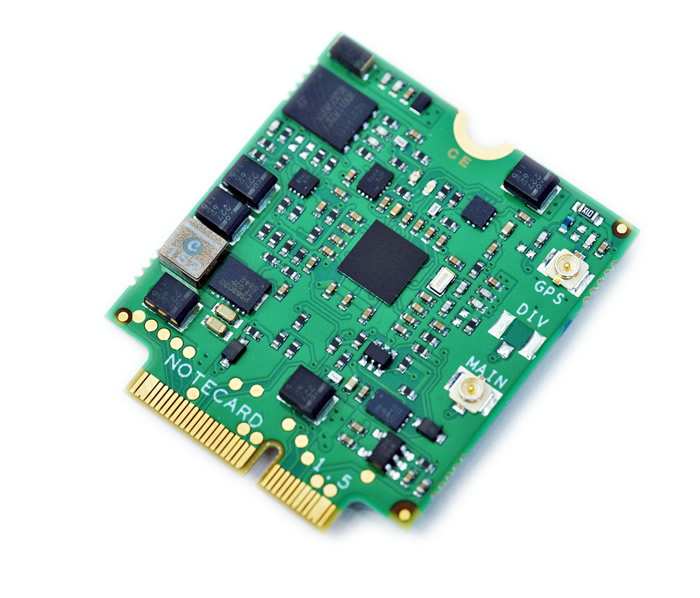
A Blues Wireless Notecard
Messages that are sent to the Notecard are stored in a queue, and then upon syncing the Notecard, the queue is sent to the Blues Wireless server named ‘Notehub’ whereby data can be further processed. For example, received messages from the Notecard can be re-routed to Google Cloud functions, AWS servers, or even a custom HTTP server for use with private projects.
After using the Notecard for just two minutes, it is blindingly obvious how useful the Notecards are for projects when it comes to simplifying IoT projects using cellular networks instead of Wi-Fi. So, let’s dive into the Notecard and see what makes this device perfect for any maker looking to get into cellular communication!
Blues Wireless Feather Starter Kit: Specs
The product that we will be reviewing is the Blues Wireless development board that includes a Swan microcontroller board, a carrier board, and the Notecard itself. It is extremely important that the Notecard, the carrier, and the microcontroller board are viewed as separate products as the Notecard operates independently from the rest of the kit and can be used in other projects.
The Swan MCU is an STM32-based board that is manufactured by Blues Wireless which is compatible with Arduino Feather boards. With USB power capabilities and a software switchable 2A regulator, the Swan microcontroller provides multiple power options while the use of the STM32 gives the designers many programming options including STM32CubeIDE and the Arduino IDE.
The carrier board includes many I/O headers and connectors for connecting the Swan microcontroller to the Notecard SoM and multiple sensors. The carrier board also includes a connector for solar panels, battery, and external SIM cards for those who do not want to use the eSIM integrated into the Notecard. Furthermore, the carrier board also integrates two different antennas used for GPS and cellular, and these need to be connected to the Notecard when it is installed (via the M.2 Key E connector).
The Notecard (which is what we are most interested in here), integrates an ARM Cortex M4 MCU with a high-performance three-axis accelerometer and temperature sensor, GNSS Quectel module for GPS, cellular modem, and STSFE secure element for storing keys and certificates. This entire board only requires a few I/O connections to a host MCU (such as serial, I2C, or SPI), and power to operate as the purpose of an SoM is to take the complexity of operation away from the main design. Essentially this is a plug-and-play device that once inserted can be forgotten about. By default, the card comes with an integrated eSIM with 500MB of data and 10 years of use which is more than enough for most projects.
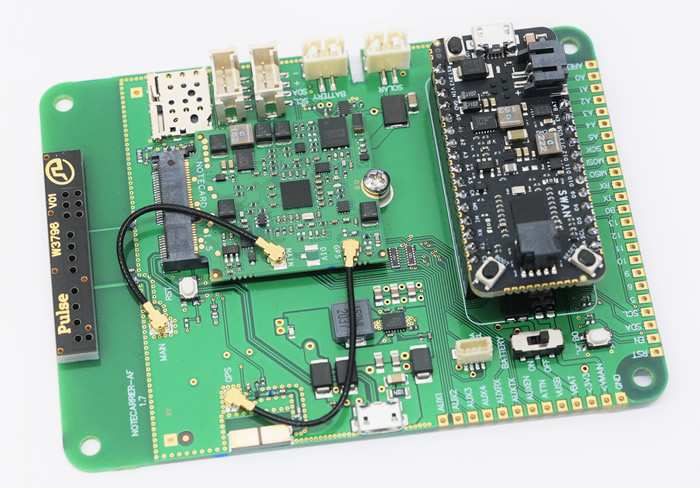
The Blues Wireless Feather Starter Kit in all of its glory
Blues Wireless Notecard: First Impression
It is important in journalism that bias is avoided at all costs and that all products should be approached from a neutral point of view. However, no matter how hard I tried to find negatives with the board, or how hard I tried to fault the Notecard I couldn’t help but fall in love with the device.
The biggest problem with advanced electronics is that they often require complex IDEs, come with poor documentation, require installation of unusual toolchains that don’t work, and have complex hardware that is hard to understand. The Notecard does away with all of this, and I was able to get cellular communication working within 2 minutes without referring to pages of documentation.
The first feature that stood out was the use of the M2 Key E Connector which allows for Notecards to be inserted into designs with ease. While this does mean that those looking to use the Notecard in custom projects will have to use a PCB production service to solder the very small connector, it does make projects extremely neat and easy to put together after the fact. Furthermore, the Notecard using the M2 Key connector demonstrates how brilliant SoMs are by removing the need for the user to construct or program the card; it works out of the box!
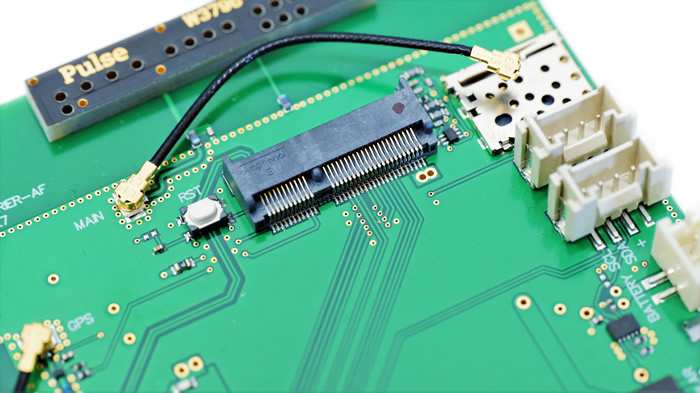
The M2 Key E Connector for use with Notecards
The second feature that makes the Notecard an excellent ‘maker’ product is that it is compatible with the Arduino IDE. While the card itself is not programmed in the Arduino IDE (because it doesn't require programming), the carrier board with the Swan microcontroller is Arduino compatible, and a Notecard library exists that makes communicating with the Notecard trivial via JSON objects.
The third feature that makes the Notecard useful is that the lack of a special programmer or communication port means that there are no driver installations or toolchains. This means that a user does not need to spend hours figuring out how to add environmental paths or check if they have installed the libraries in the right location.
The fourth feature that really puts the cherry on the cake is that the dev board can be connected to via USB and the Notecard directly messaged to via a browser on the tutorial page. This means that commands in the tutorial page can be directly sent to the Notecard which allows for users to follow the tutorials while simultaneously working with the Notecard.
Things You Need To Do
It is very little you need to do when working with the Notecard which is why it is such an excellent maker product. However, those looking to use the dev board with the Swan microcontroller will need to install the STM32 boards into the Arduino IDE, but this can easily be done by following the tutorials presented on the Blues Wireless site.
In order to use Notecards, you require a Blues Wireless account which gives you access to the Notehub which is the central server that all Notecards communicate with. Accounts on Notehub are free, and data can be rerouted from Notehub to any service of your choosing.
What can the Notecard do?
At its core, the Blues Wireless development kit is designed to work with the various Notecards they produce, and the Notecard that we have in this particular example is a cellular version. This means that it can send data to the Notehub over cellular networks, and this means that it can work just about anywhere with cellular reception. The cellular Notecard also integrates a GPS receiver which allows for global positioning, and this can be particularly useful for identifying the location of a particular sensor.
The board itself has various I/O connectors for connecting to other sensors which allow the main microcontroller, the Swan, to read sensor data. This allows for the potential to create sensor-based projects and this is further supported with the solar power and battery connectors that can allow for the board to operate remotely.
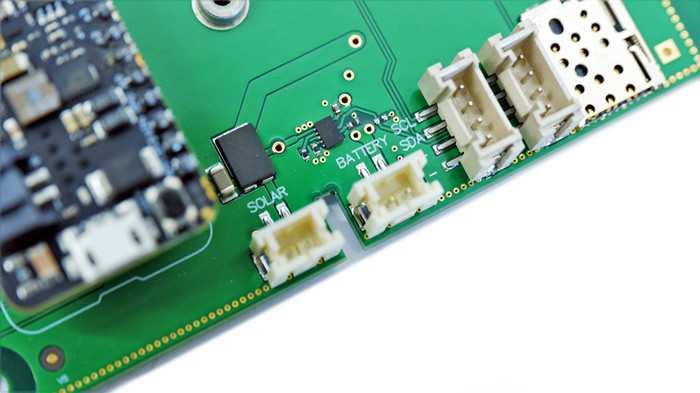
Various IO for connecting to solar, batteries, and sensors
What can the Notecard be used for?
Cellular networks are particularly useful for applications that need to operate in remote locations where Wi-Fi and Bluetooth are unavailable. Even in the deepest parts of the English countryside, cellular coverage still exists and this allows for the Notecard to retain an internet connection to the Notehub.
As such, the cellular Notecard is ideal for remote IoT projects such as environmental sensors used in the countryside. But the card can also be used in cities where Wi-Fi is difficult to establish (such as the tops of buildings or in sidestreets), and the use of a battery and solar panel removes the need for a power source. Thus, installation is as simple as mounting a completed unit with a few screws and an appropriate enclosure.
The Notecard can also be used for remote communication in a home network as a redundancy. For example, a power outage would most likely take down all internal networks (such as Wi-Fi and ethernet), but a battery-powered cellular device could still monitor and send updates to a remote service.
Should you buy a Blues Wireless Notecard?
As stated before, having journalistic neutrality is an essential part of my job, but this is really hard to do when considering that the dev kit from Blues Wireless was up and running in 30 seconds, and cellular messages were sent in two minutes from powering up. The lack of toolchains or complex IDEs makes it trivial to use the device, and the compatibility with the Arduino IDE removes the need for complex installations or configuration of path variables.
Cellular communication is not trivial to achieve, and many cellular platforms require the user to interface with complex modems. The Notecard, however, integrates an entire system onto a single small PCB that makes communication over cellular networks as simple as sending a JSON command with a destination parameter (your unique program ID found on the Notehub site), and then whatever data you wish to append.
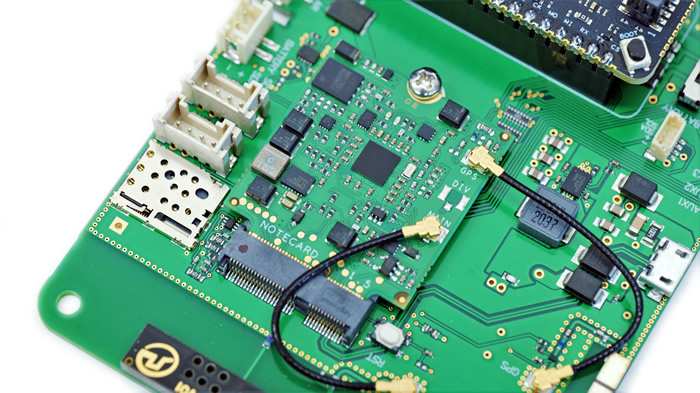
The Notecard and carrier make it trivial to make cellular projects!
The other major feature of the Notecard is that it integrates all the important security features needed to create a secure project with the use of a dedicated hardware security IC that stores keys and certificates. This is especially important in a world where the threat from cyberattacks on IoT devices continues to exponentially grow.
But the best feature by far is that the Notecard, when connected to the dev kit, can be communicated with in-browser on the tutorial and help pages. Example code on the website can directly be downloaded to the Notecard and the response can be seen which makes the tutorials interactive. Thus, you can compare the output of your Notecard to what is shown on the tutorial pages.
What downsides does the Blues Wireless Notecard have?
The Notecard doesn’t have many downsides, but the ones that it does have can break a project. The biggest problem by far is the use of the M2 Key E connector as this is a ‘maker unfriendly’ connector. Of course, PCB services can solder these connectors automatically onto projects, and expander boards for these connectors do exist, but it adds a level of complexity when trying to integrate the Notecard into a breadboard or stripboard project.
The second disadvantage of the Notecard is its size. While the board is very small (30 x 35mm), it's still bigger than a project that integrates all the needed components onto a singular PCB. Thus, the board doesn’t provide the most efficient use of space.
The third disadvantage of the Notecard is that it uses an eSIM which means that the network carrier is fixed, and the data availability is limited (around 500MB). It may be possible to add more data, but to do so is not entirely obvious, especially when considering that eSIMs are a very new technology, and not all carriers support them.
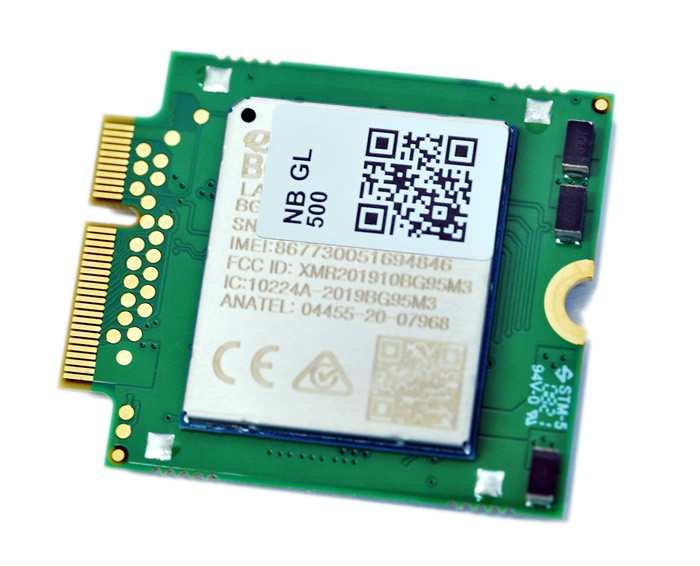
Small, compact, but no SIM slot making it hard to change
The fourth disadvantage of the Notecard is that it only works with Notehub, and this means that trying to send data to custom servers adds latency. It also means that a project requires a Notehub account, and this could potentially introduce privacy issues as GPS data can be obtained and stored on Notehub.
Blues Wireless Notecard: Conclusion
The Notecard may have a few disadvantages, but these are dwarfed by the many advantages that it has. A simple to use platform with excellent documentation, JSON messages between the card and a host controller, the ability to program the device directly via a USB port, and support for the Arduino IDE makes the Blues Wireless cellular Notecard a powerful SoM to develop remote cellular devices. Furthermore, different Notecards exist for different networks, and this allows for a single project to quickly switch between network technologies depending on what is available.
Electroscore: 5/5 ![Electroscore: 5]()
Pros:
- Easy to use
- Fantastic documentation
- Arduino IDE compatible
Cons:
- M2 Key E connector
- Size could be an issue for very small projects
















































Leave your feedback...